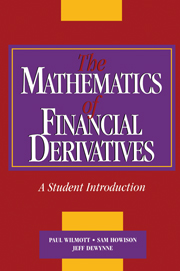Book contents
- Frontmatter
- Contents
- Preface
- Part One Basic Option Theory
- 1 An Introduction to Options and Markets
- 2 Asset Price Random Walks
- 3 The Black–Scholes Model
- 4 Partial Differential Equations
- 5 The Black–Scholes Formulæ
- 6 Variations on the Black–Scholes Model
- 7 American Options
- Part Two Numerical Methods
- Part Three Further Option Theory
- Part Four Interest Rate Derivative Products
- Hints to Selected Exercises
- Bibliography
- Index
7 - American Options
from Part One - Basic Option Theory
Published online by Cambridge University Press: 05 June 2012
- Frontmatter
- Contents
- Preface
- Part One Basic Option Theory
- 1 An Introduction to Options and Markets
- 2 Asset Price Random Walks
- 3 The Black–Scholes Model
- 4 Partial Differential Equations
- 5 The Black–Scholes Formulæ
- 6 Variations on the Black–Scholes Model
- 7 American Options
- Part Two Numerical Methods
- Part Three Further Option Theory
- Part Four Interest Rate Derivative Products
- Hints to Selected Exercises
- Bibliography
- Index
Summary
Introduction
We recall from Section 1.5 that an American option has the additional feature that exercise is permitted at any time during the life of the option. (Of course, this relies on the assumption that there is a well-defined payoff for early exercise.) The explicit formulre quoted in Chapter 5, which are valid for European options where early exercise is not permitted, do not necessarily give the value for American options. In fact, since the American option gives its holder greater rights than the European option, via the right of early exercise, potentially it has a higher value. The following arbitrage argument shows how this can happen.
Figure 7.1 shows that before expiry there is a large range of asset values S for which the value of a European put option is less than its intrinsic value (the payoff function). Suppose that S lies in this range, so that P(S, t) < max(E - S, 0), and consider the effect of exercising the option. There is an obvious arbitrage opportunity: we can buy the asset in the market for S, at the same time buying the option for P; if we immediately exercise the option by selling the asset for E, we thereby make a risk-free profit of E – P – S. Of course, such an opportunity would not last long before the value of the option was pushed up by the demand of arbitragers.
- Type
- Chapter
- Information
- The Mathematics of Financial DerivativesA Student Introduction, pp. 106 - 132Publisher: Cambridge University PressPrint publication year: 1995
- 1
- Cited by



